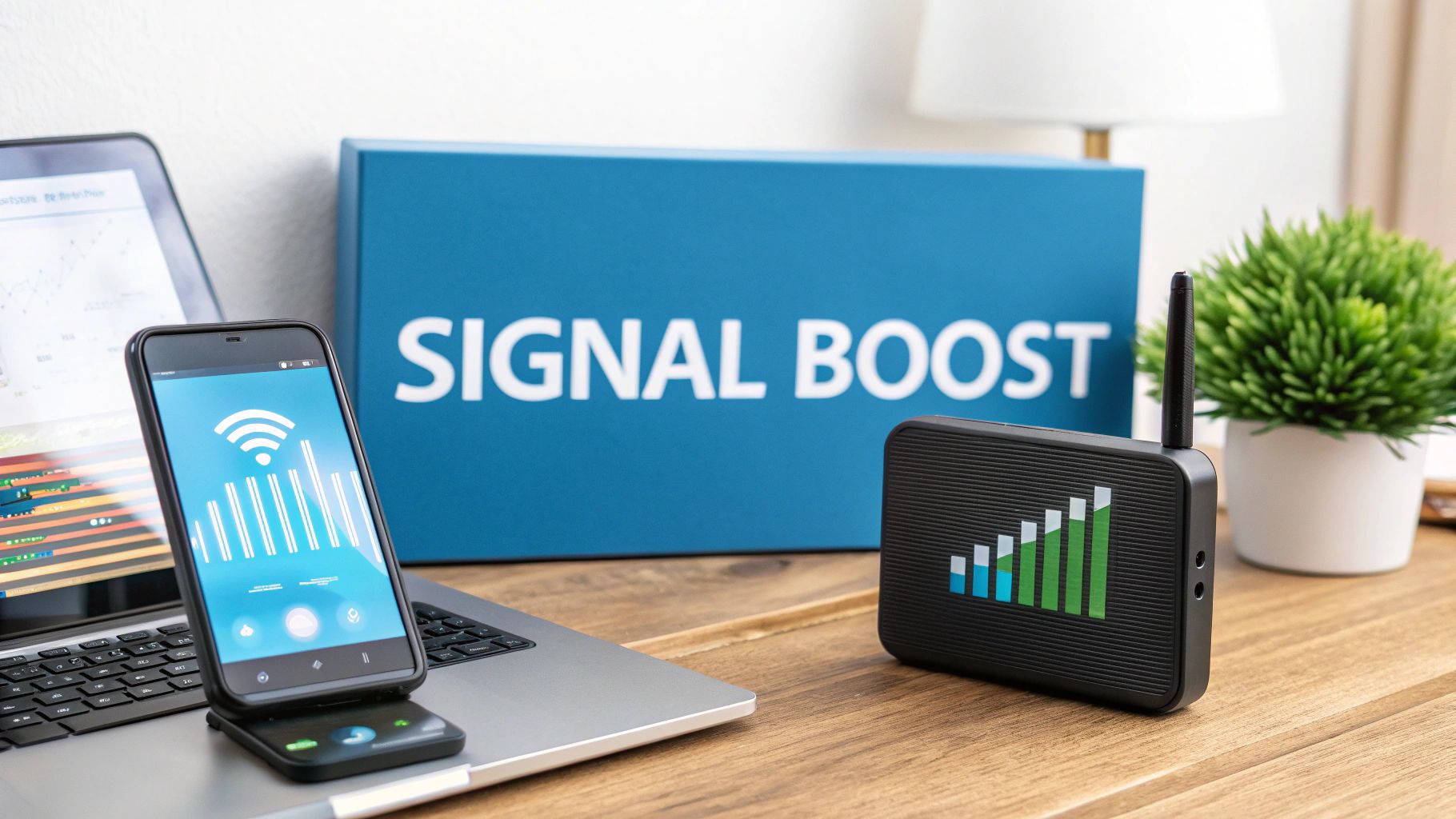

· By James
Signal Booster LTE: Choose the Perfect Cellular Amplifier
Understanding How LTE Signal Boosters Actually Work
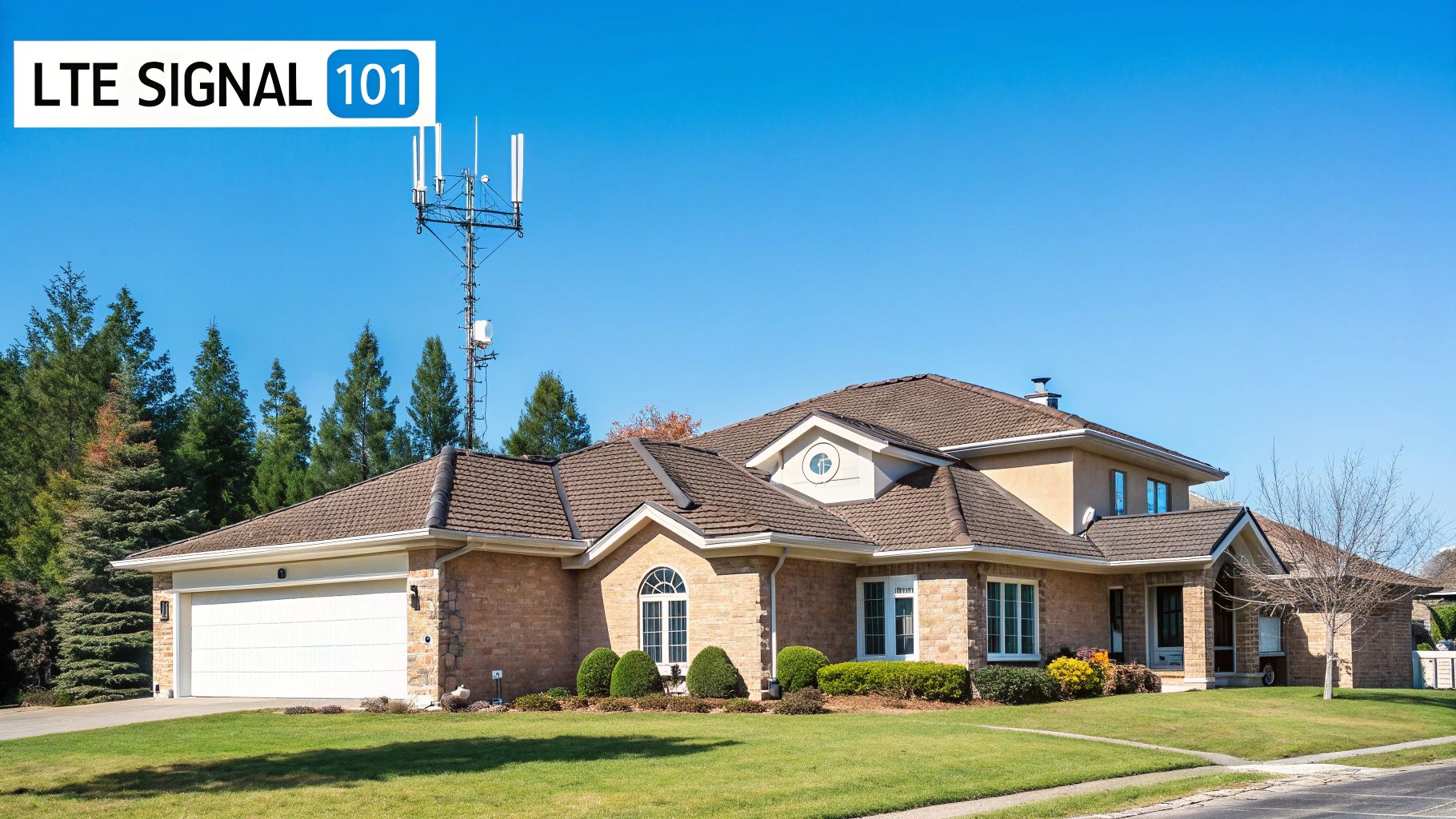
Think of an LTE signal booster as a megaphone for your cellular connection. It captures existing LTE signals, amplifies them, and then rebroadcasts a stronger signal within your home, office, or vehicle. This process involves several key components working in concert.
Key Components of an LTE Signal Booster
-
Outside Antenna: This antenna, placed outside your building or vehicle, is strategically positioned to capture even weak LTE signals from nearby cell towers. The captured signal is then sent to the amplifier.
-
Amplifier: The amplifier is the core of the system, boosting the weak signal it receives. This increases the signal strength significantly. Amplifiers are characterized by their gain, measured in decibels (dB), indicating the level of amplification.
-
Inside Antenna: Once amplified, the signal is broadcast throughout your desired area by the inside antenna, typically placed inside your home or office.
-
Cables: Specialized coaxial cables connect all the components, carrying the signal between the antennas and the amplifier. High-quality cables are essential to minimize signal loss.
Why LTE Requires Specific Amplification
Modern LTE technology operates on specific frequency bands. An LTE signal booster must be compatible with these frequencies for effective amplification. Choosing the right booster is crucial. An incorrect booster can lead to minimal improvement, or even interference.
Measuring Signal Improvement
Signal strength is measured in dBm (decibel-milliwatts). A higher dBm means a stronger signal. You might also see signal strength represented by bars on your phone, but dBm provides a more precise measurement. Even a small improvement in dBm can noticeably improve call quality and data speeds. For example, a jump from -110 dBm to -90 dBm can transform dropped calls into clear conversations. You might be interested in: How to Get Internet in RV: Easy & Reliable Solutions.
Overcoming Signal Obstacles
LTE signal boosters help overcome common signal-weakening obstacles:
- Building Materials: Materials like concrete, brick, and metal can significantly block cellular signals.
- Distance from Cell Towers: Weak signals are common in rural areas due to the distance from cell towers.
- Terrain: Hills, trees, and other geographical features can obstruct signals.
By understanding these components and how they interact, you can better appreciate how an LTE signal booster enhances connectivity.
Why the Signal Booster Market Is Exploding Right Now
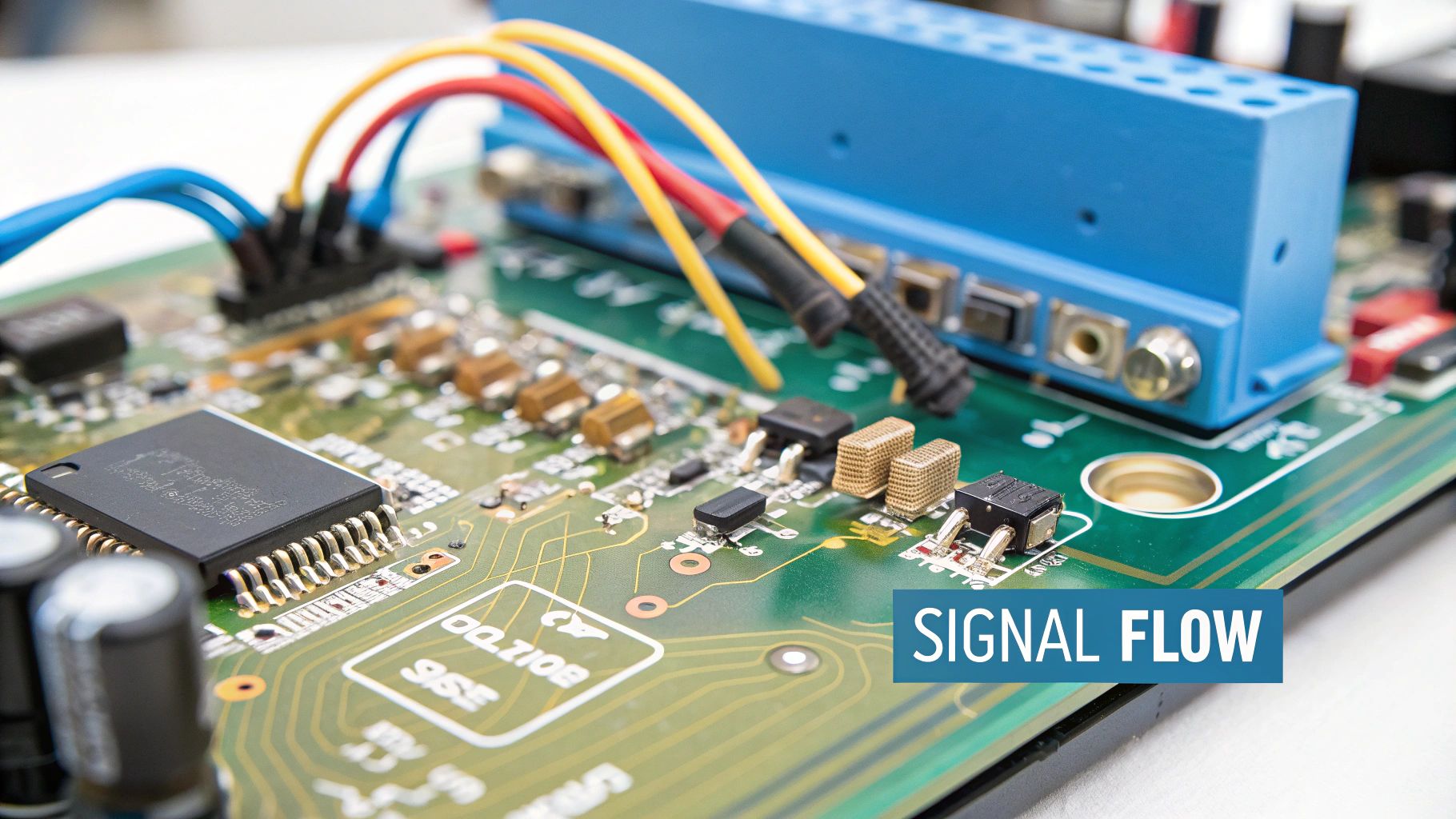
The signal booster industry is experiencing remarkable growth. This isn't a temporary fad; it's a response to how we connect in today's world. This section explores the key factors driving this market boom and why a signal booster LTE is a smart investment.
Smartphone Proliferation and the IoT Boom
The sheer number of smartphones, coupled with the rise of the Internet of Things (IoT), has dramatically increased the need for strong cellular connections. Think about it: everything from your smart refrigerator to your fitness tracker needs a stable signal.
This constant demand puts a strain on networks. Signal boosters help bridge the gap by amplifying existing signals and extending coverage to meet this growing need.
Advancements in Signal Booster Technology
Signal boosters are also becoming more effective and affordable thanks to improvements in antenna design and electronic components. Today's boosters are smaller, more powerful, and simpler to install.
Some even include smart features that automatically adapt to changing signal conditions for peak performance. These enhancements make signal boosters a practical solution for a broader audience.
Urbanization, Remote Work, and 5G Rollout Complexities
Several factors contribute to the rising demand for signal boosters. The market was valued at approximately $16.89 billion in 2024 and is projected to reach $19.39 billion by 2025, a 14.8% compound annual growth rate (CAGR). The rollout of 5G networks, better electronic components, and our reliance on cellular data are major contributors. For a deeper dive, check out this Signal Booster Market Report.
Urban areas often experience signal congestion and interference. Remote work demands reliable connectivity from anywhere. And the transition to 5G, while offering faster speeds, presents challenges with signal reach and building penetration. Signal boosters offer vital support in all these situations.
Sustained Demand Across Sectors
The demand for signal enhancement solutions is steady and growing across both residential and commercial sectors. Dense cityscapes, the rise of working from home, and the complexities of 5G implementation all highlight the need for reliable connectivity. As these trends continue, the signal booster market is expected to keep expanding.
Choosing the Right LTE Signal Booster for Your Needs
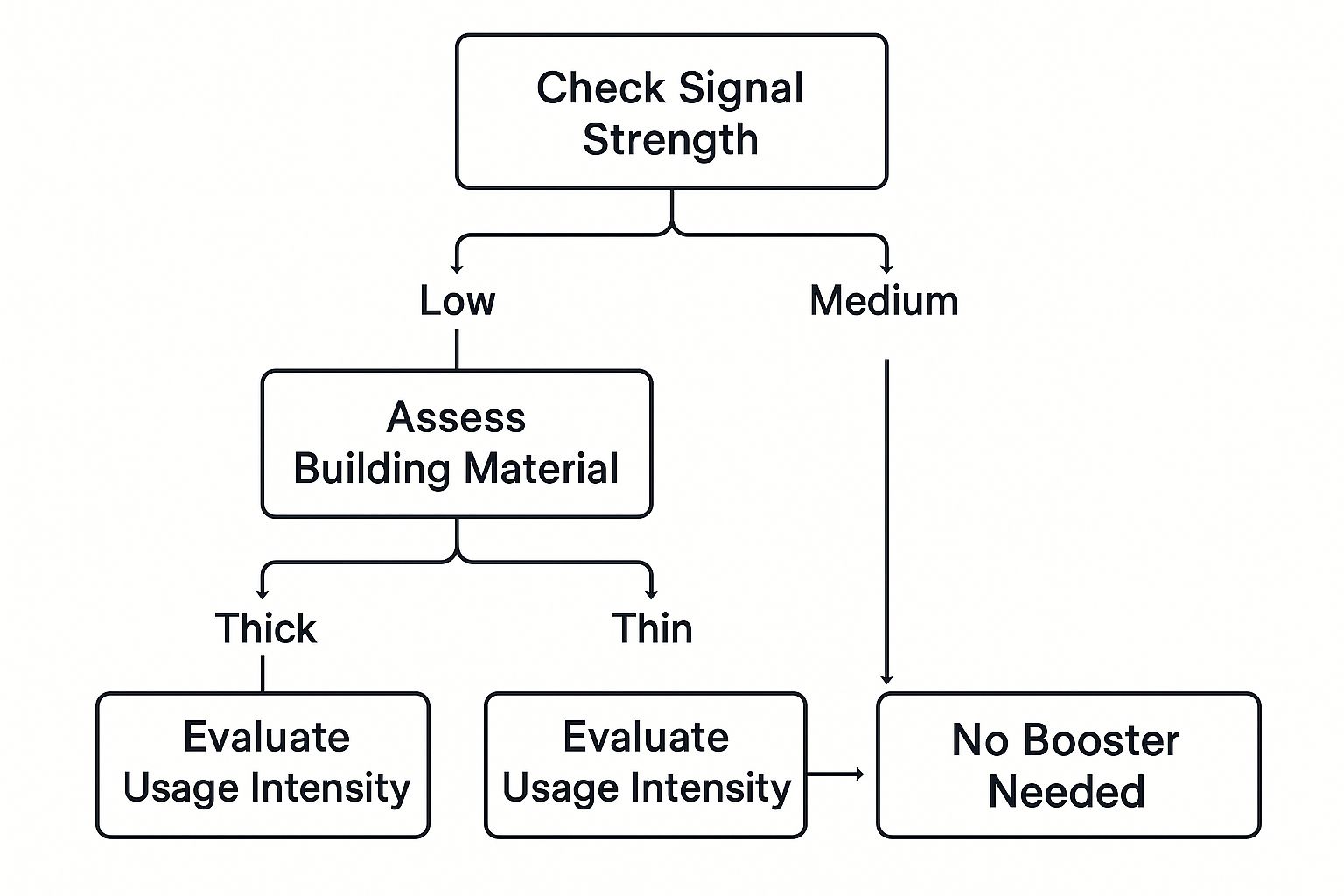
This infographic illustrates how factors such as signal strength, building materials, and usage intensity can help determine if an LTE signal booster is right for you. Signal strength is a major consideration, especially when combined with obstacles like thick walls. High data usage also contributes to the need for a booster.
Not all LTE signal boosters are created equal. The right choice depends on your individual needs and the environment where you'll be using it. Choosing wisely can mean the difference between a significant improvement and a negligible one. This requires understanding the different types of boosters available.
Categories of LTE Signal Boosters
LTE signal boosters come in several forms to meet various needs:
- Desktop Boosters: These compact boosters are designed for small spaces, such as a home office or single room. They offer focused coverage for one or two devices.
- Building Boosters: Covering larger areas, such as entire homes or offices, these powerful systems offer significantly greater coverage. They are more complex to install than desktop models.
- Vehicle Boosters: Ideal for cars, trucks, and RVs, these boosters are designed for mobile use, keeping you connected on the road. For more on mobile internet for RVs, check out this resource: Top Mobile Internet for RV Deals 2025.
Understanding Booster Specifications
Beyond booster categories, understanding key specifications is important:
- Gain: Measured in decibels (dB), gain represents the signal amplification. A higher dB gain is generally preferred, especially in areas with weak signals.
- Coverage Area: Measured in square footage, this specification indicates the area the booster can effectively cover. It's crucial to choose a booster with adequate coverage for your space.
- Frequency Bands: Confirm that the booster supports the LTE frequency bands used by your mobile carrier to ensure compatibility.
To help you choose the right booster, let's look at a comparison of the different types.
The following table provides a detailed comparison of different LTE signal booster types to help you choose the best one for your needs.
LTE Signal Booster Types Comparison:
| Booster Type | Coverage Area | Ideal Use Case | Key Features | Price Range |
|---|---|---|---|---|
| Desktop Booster | Single room or small office (up to 1,500 sq ft) | Home office, apartment, small business | Compact, easy to install, affordable | $50 - $300 |
| Building Booster | Entire home or office building (up to 50,000 sq ft) | Large homes, office buildings, multi-story buildings | High gain, wide coverage area, multiple simultaneous connections | $300 - $1,500 |
| Vehicle Booster | Car, truck, RV, boat | Travel, commuting, off-grid areas | Portable, vehicle-specific mounting options, improves signal on the go | $100 - $500 |
This table summarizes the key differences between desktop, building, and vehicle boosters, highlighting their coverage areas and ideal use cases. Choosing the right type depends largely on the size of the area needing a boost and whether the application is stationary or mobile.
Consumer-Grade vs. Commercial-Grade
Consumer-grade boosters are generally easier to install and less expensive. Commercial-grade boosters, however, offer higher gain and wider coverage, making them suitable for large buildings or areas with weak signal. For businesses looking to improve their online presence, resources like this guide on how to Boost Online Sales may be helpful.
By considering these factors, you can select the right LTE signal booster to significantly improve your connectivity.
Installation Strategies That Actually Maximize Performance
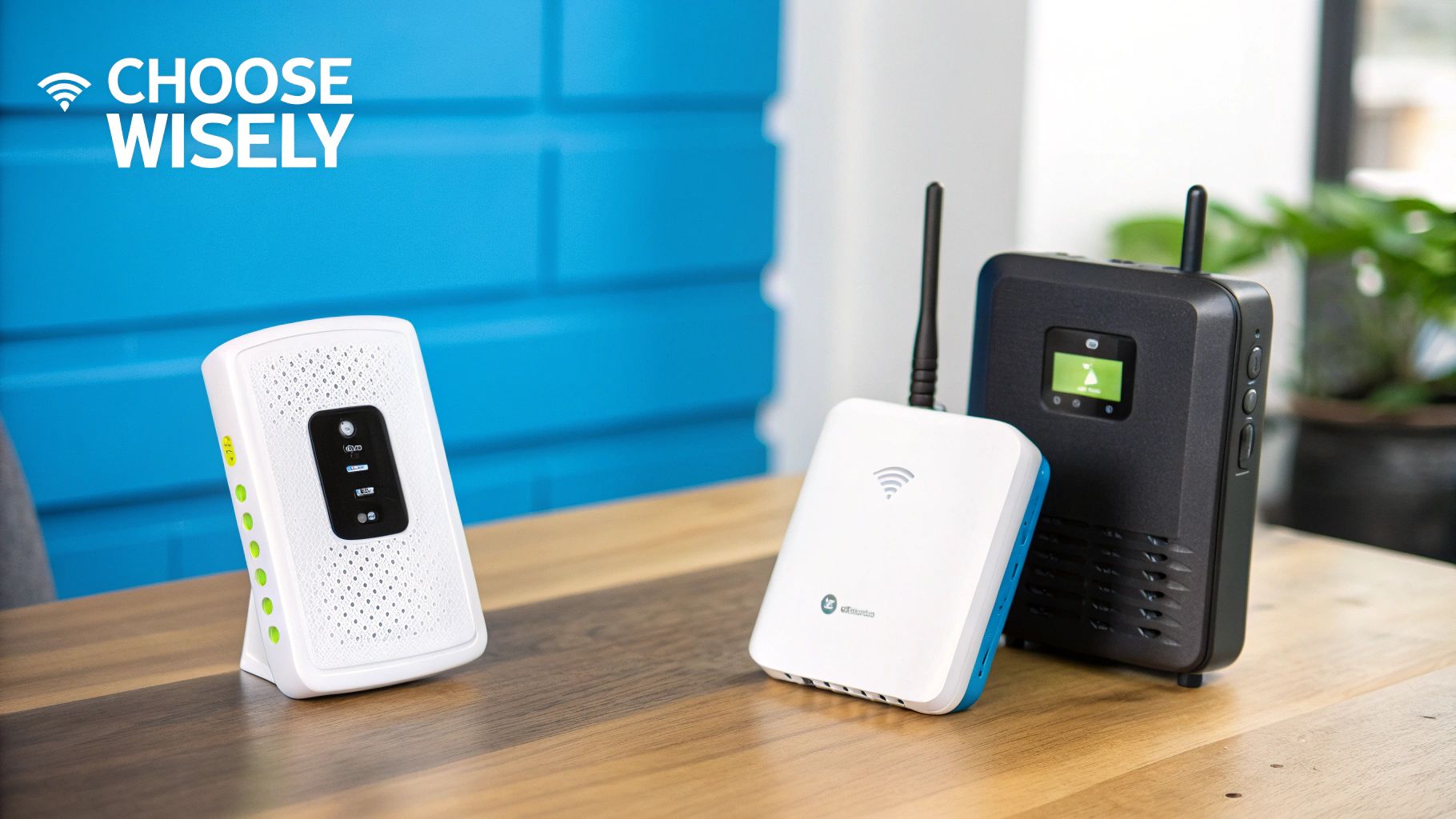
Proper installation is key to getting the most out of your signal booster lte. The difference between a slight improvement and a significant boost often depends on the installation quality. This guide offers proven techniques to ensure you maximize your investment. When selecting an LTE signal booster, identifying the right search terms is important. Consider researching low hanging fruit keywords for this process.
Conducting an Effective Site Survey
Before starting the physical installation, a site survey is crucial. This involves finding the areas with the strongest outside cellular signal. You can typically use your phone's signal bars or a dedicated signal meter app. The spot with the best outside signal is ideal for your outside antenna.
Optimal Antenna Placement
Antenna placement significantly impacts performance. The outside antenna should be mounted as high as possible, aimed at the closest cell tower. The inside antenna belongs where you need the strongest boosted signal. Maintaining 20-30 feet between antennas is important to prevent oscillation, which can negatively affect the booster.
Roof mounting the outside antenna and placing the inside antenna centrally within the house is often effective.
Cable Routing and Safety
Use high-quality coaxial cables to connect the antennas and amplifier. Shorter, straighter cable runs minimize signal loss. Secure the cables properly to avoid damage and ensure a clean setup. Always prioritize safety when working at heights or with electrical wiring.
Troubleshooting Common Installation Mistakes
Several common errors can significantly impact LTE signal booster effectiveness:
- Insufficient Antenna Separation: Placing antennas too close together can create feedback loops.
- Incorrect Antenna Aiming: Poorly aimed outside antennas can limit signal capture.
- Using Low-Quality Cables: Substandard or damaged cables contribute to signal loss.
By following these installation strategies and avoiding these pitfalls, you'll optimize your LTE signal booster's performance, ensuring the reliable cellular connection you need. This careful approach improves both call quality and data speeds.
Future-Proofing Your Signal Booster Investment
Investing in a signal booster for LTE is a significant step towards reliable connectivity. But with technology constantly changing, how can you ensure your investment remains relevant and effective for years to come? This section explores how the signal booster industry is adapting to future connectivity demands.
The Evolving Landscape of Cellular Technology
The cellular world is constantly evolving. 5G is already here, and future wireless standards are on the horizon. Signal booster technology is adapting to these changes, ensuring compatibility with advanced 5G implementations and emerging wireless technologies. Forward-thinking manufacturers are developing boosters that can handle the higher frequencies and wider bandwidths of these new technologies.
Some boosters now use smart gain control, automatically adjusting to changing signal conditions. This dynamic approach optimizes performance across various cellular generations, from LTE to future 5G advancements. This adaptability is key to future-proofing your investment.
The Growing Need for Signal Enhancement
The demand for strong, reliable cellular connections isn't disappearing; in fact, it's growing. The rise of smart cities, increasing urbanization, and government programs focused on connectivity all contribute to a sustained need for signal enhancement solutions.
Building materials and challenging terrain also create signal obstacles. Signal boosters offer a solution to overcome these hurdles, ensuring reliable connectivity in diverse environments. For more on connectivity challenges, you might be interested in: Read also: Rural High-Speed Internet: Bridging the Digital Divide.
Technological Advancements and Regulatory Frameworks
The signal booster industry is driven by more than just new cellular standards. Innovations in antenna technology, amplifier design, and overall system efficiency promise even better performance and coverage in the future. This constant innovation ensures that signal boosters become more effective and user-friendly.
Regulatory frameworks are also evolving to support wider signal booster adoption. This increasing acceptance solidifies the role of signal boosters in the future of connectivity, making them a sound long-term investment. The signal booster market is projected to reach $33.36 billion by 2029, with a 14.5% CAGR from 2025 onwards. Factors like technological advancements, urbanization, and government initiatives are driving this growth. You can find more detailed statistics here.
Ensuring a Wise Investment
By considering these factors – evolving cellular technology, growing demand, technological advancements, and regulatory changes – you can make informed decisions about your signal booster purchase. Choosing a booster from a reputable manufacturer that prioritizes innovation and future compatibility will help ensure your investment provides reliable connectivity today and for years to come. Prioritizing adaptability, advanced features, and a commitment to technological progress will protect your investment and ensure your signal booster continues to enhance your connectivity experience.
North American Market Opportunities and Regional Advantages
The North American market presents significant opportunities for signal booster LTE technology. Unique geographical features and regulatory environments create a fertile ground for growth. Let's explore why this market is experiencing a surge in demand and how these regional characteristics contribute to a positive outlook for signal enhancement solutions.
Connectivity Challenges: Urban vs. Rural
North America's diverse landscapes present unique connectivity challenges. In densely populated urban areas, buildings and infrastructure can obstruct cellular signals, leading to pockets of weak coverage. Network congestion further complicates matters, causing slow data speeds and dropped calls.
Rural areas, however, face even greater obstacles. Vast distances between cell towers and natural obstructions like mountains and forests often result in weak or nonexistent signals. This digital divide underscores the need for solutions like signal boosters.
The 5G Rollout: A Catalyst for Signal Boosters
The ongoing deployment of 5G networks across North America is a double-edged sword for connectivity. While promising faster speeds and greater capacity, 5G signals have a shorter range and struggle to penetrate buildings. This creates new opportunities for signal boosters to enhance 5G coverage and extend its reach, particularly indoors.
This transition also means existing LTE signal boosters will remain crucial. They'll ensure reliable connectivity during and after the 5G rollout, as LTE infrastructure continues to be essential for many areas.
Smart Device Proliferation: Fueling Demand
Our growing dependence on smartphones, tablets, and other smart devices drives demand for reliable cellular coverage. From connected homes and vehicles to the expanding Internet of Things (IoT), consistent connectivity is now a necessity.
This reliance on mobile devices requires robust solutions to address connectivity gaps. Signal boosters become essential for ensuring these devices function optimally, whether at home, in the office, or on the go. The North American market for cell phone signal boosters was valued at $3,260.88 million. It's projected to grow at a CAGR of 9.2% through 2031. This growth is fueled by the increasing need for reliable mobile connectivity, especially in rural areas with weaker coverage. Learn more here.
Regional Advantages and Market Growth
North America's relatively open regulatory environment regarding signal boosters also fuels market growth. This framework allows for greater innovation and wider adoption compared to regions with stricter regulations. This advantage fosters competition and drives the development of more efficient and effective solutions, benefiting consumers and businesses.
Key Takeaways
This section offers practical steps for implementing signal booster LTE solutions and assessing connectivity gains. It provides helpful advice on evaluating your existing signal, choosing the right booster, and ensuring a smooth installation and optimization process.
Assessing Your Current Signal Situation
Before purchasing a signal booster, it's essential to understand your current cellular environment. This preliminary assessment will help you make informed decisions about the type of booster you need.
-
Measure Signal Strength: Use the signal bars on your phone or a signal meter app like OpenSignal or Network Cell Info Lite to measure signal strength in dBm. Take note of locations with the weakest and strongest signals.
-
Identify Problem Areas: Locate specific areas in your home, office, or vehicle where the signal is consistently weak. These are your target areas for improvement.
-
Consider Obstacles: Identify any potential obstructions that might be impacting your signal. Common obstacles include building materials, terrain, and distance from cell towers.
Selecting the Right Booster Technology
Choosing the appropriate booster type is crucial for achieving optimal performance. The right booster will depend on your specific needs and environment.
-
Coverage Area: Select a booster with a coverage area that matches the size of the space you need to cover. Don't choose a booster designed for a large home if you only need to improve the signal in a small office.
-
Booster Type: Different booster types cater to various applications. Choose a desktop booster for a single room, a building booster for a larger area, or a vehicle booster for on-the-go connectivity.
-
Gain: The booster's gain, measured in dB, indicates how much it amplifies the signal. Choose a booster with sufficient gain to address your specific signal strength needs.
Signal Booster Implementation Checklist
To help you through the implementation process, we've created a checklist outlining the key steps involved. This table breaks down each phase, highlighting the essential tasks, success criteria, and estimated timelines.
Before we dive into the table, remember that these timelines are estimates and can vary based on the complexity of your installation. Use this checklist as a guide to plan your project effectively.
| Implementation Phase | Key Tasks | Success Criteria | Timeline |
|---|---|---|---|
| Site Assessment | Measure signal strength, identify problem areas, consider obstacles | Clear understanding of current signal conditions | 1-2 days |
| Product Selection | Choose booster type, coverage area, and gain based on assessment | Booster specifications match requirements | 1-2 days |
| Installation Planning | Determine optimal antenna placement, cable routing, and mounting options | Detailed installation plan minimizes potential issues | 1-2 days |
| Installation | Install booster system according to plan, ensuring proper grounding and cable connections | System installed safely and correctly | 1-2 days |
| Optimization | Test and adjust antenna placement and amplifier settings to maximize performance | Signal strength significantly improved in target areas | 1-2 days |
This checklist helps ensure a systematic approach to signal booster deployment, leading to optimal performance and improved connectivity. Each phase builds upon the previous one, creating a solid foundation for success.
Measuring Performance Improvements
After installing your signal booster, it's important to track the improvements. This helps confirm that the booster is working effectively and addressing your initial concerns.
-
Re-measure Signal Strength: Check the signal strength in the areas that were previously weak. Compare these measurements to your pre-installation readings to quantify the improvement.
-
Monitor Data Speeds: Use speed test apps like Ookla Speedtest or Fast.com to assess any changes in your data download and upload speeds.
-
Observe Call Quality: Pay attention to any enhancements in call clarity and a reduction in dropped call frequency. These are often noticeable improvements after booster installation.
These steps provide a framework for selecting vendors and products, setting realistic expectations, and maximizing your investment in improved connectivity. Consider SwiftNet Wifi, a high-speed 5G internet service provider catering to rural areas and RV travelers, for your connectivity needs. Learn more about their services by visiting SwiftNet Wifi.

